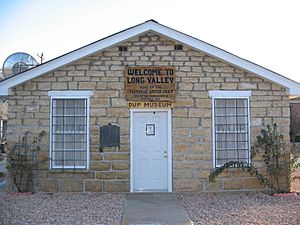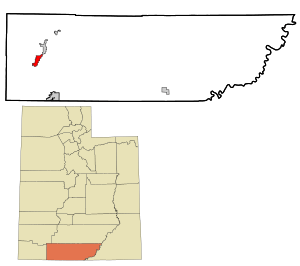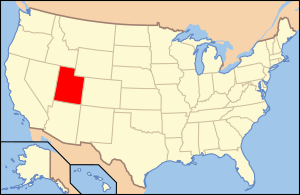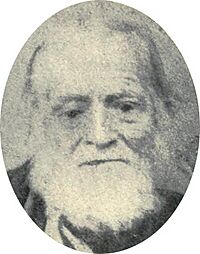Orderville, Utah facts for kids
Quick facts for kids
Orderville, Utah
|
|
|---|---|

Orderville museum of the Daughters of Utah Pioneers, December 2007
|
|

Location within Kane County and the State of Utah
|
|

Location of Utah within the United States
|
|
| Country | United States |
| State | Utah |
| County | Kane |
| Founded | 1875 |
| Incorporated | 1934 |
| Named for | United Order |
| Area | |
| • Total | 8.72 sq mi (22.58 km2) |
| • Land | 8.72 sq mi (22.58 km2) |
| • Water | 0.00 sq mi (0.00 km2) |
| Elevation | 5,449 ft (1,661 m) |
| Population
(2010)
|
|
| • Total | 577 |
| • Estimate
(2019)
|
592 |
| • Density | 67.91/sq mi (26.22/km2) |
| Time zone | UTC-7 (Mountain (MST)) |
| • Summer (DST) | UTC-6 (MDT) |
| ZIP code |
84758
|
| Area code(s) | 435 |
| FIPS code | 49-57080 |
| GNIS feature ID | 1431023 |
Orderville is a small town in Kane County, Utah, United States. In 2010, about 577 people lived there. The town was started in 1875 and was special because it followed a unique way of life called the United Order. This system helped the community grow for a while, but it ended in 1885. Today, the town is led by Mayor Lyle Goulding.
Contents
History of Orderville: A Unique Community
Orderville was founded in 1875 under the direction of Brigham Young, a leader of the Church of Jesus Christ of Latter-day Saints. The main goal was to live by the United Order. This was a voluntary way of life where people shared everything. Many of the first settlers were people who had lost their homes in other settlements.
When Orderville started, it had about 335 acres of land. The community owned many animals, including oxen, cows, horses, sheep, hogs, and chickens. They also had a lot of lumber. The settlement began without any debt, which was a great start.
How Did People Live in Orderville?
Homes in Orderville were usually one or two rooms. They were built around a central town square. The community also built shared dining halls and public buildings. The dining hall opened on July 24, 1875. It prepared meals for over 80 families. Men ate first, then women and children. Meals were served at 7 AM, 12 PM, and 6 PM.
Under the United Order, no one in Orderville owned private property. Everything was considered to belong to God. Each person was in charge of their personal items. Each family was in charge of their home. For the first two years, settlers worked without getting paid money. They could take supplies and food as they needed. The town's bishop managed how goods were shared.
Work done by everyone, including men, women, and children, was recorded. This helped keep track of labor. In 1877, they started using a price system instead of just credits. Money values were given to all work and goods. At the start of each year, any debts were cleared. People who had earned extra money would give it back to the community.
The settlers grew their own crops and had small farms. They also used local materials to make many things. These included soap, brooms, buckets, and furniture. They even made silk thread and wove it into clothes. Later, they opened their own leather factory. There were many different jobs in Orderville, like blacksmiths, clerks, artists, and musicians. A doctor named Priddy Meeks came to Orderville in 1876. The community also gave 10% of its earnings to the Church, following a practice called tithing.
How Was the Community Managed?
A group of nine men, called the Board of Management, ran the community. They were chosen each year. This board bought and sold goods for everyone. They also decided what work needed to be done. The town's bishop was usually the president of the board. This meant that spiritual and daily life were closely connected.
Orderville was divided into 33 different departments. Each year, the board met with the department leaders. They figured out what was needed and how many workers each department would get.
To join Orderville, new members needed a two-thirds vote from the community. Newcomers were interviewed to understand why they wanted to join. They were also asked about their habits and beliefs. New members had to agree to follow strict rules. These rules included no swearing and giving up tobacco, tea, and coffee. If members wanted to leave, they got back any money they had put in. They also received any extra credits they had earned that year. If they had debts, these were usually forgiven.
Why Was Orderville So Successful?
Many communities in Utah tried the United Order in the 1870s. But Orderville was special because it was very successful and lasted a long time. In just a few years, Orderville became a strong and self-sufficient community. This means they could provide for all their own needs.
The success and wealth of Orderville attracted more settlers. The town grew to about 700 people. Orderville not only met its own needs but also produced extra goods to sell to other towns. This extra money was used to buy more land and equipment. The fact that many settlers started out very poor likely made them more dedicated to the United Order's principles.
The End of the United Order
The United Order lasted for about 10 years in Orderville. In the early 1870s, the economy in southern Utah started to get better. Silver was discovered nearby, which brought railroads and more people to the area. Local farmers could now sell their goods for more money. Neighboring towns that used to buy from Orderville could now get goods from other places. This made Orderville's goods seem "old fashioned."
Young people in Orderville started to wish for the same things as youth in other towns. This caused some problems within the community. Because of these issues, the shared dining system stopped in 1880. Three years later, the way they valued work changed. This created some unfairness that hadn't been there before. Families also started getting their own spending money. These changes caused more problems and disagreements.
While these internal issues were happening, a new law also affected Orderville. In 1885, the Edmunds Act was enforced. This law led to many of the community's leaders being jailed. Others had to go into hiding. This effectively ended the United Order in Orderville. The community held an auction where people used their credits to buy things. Orderville continued to run its leather factory, wool factory, and sheep business until 1889.
Geography and Climate
Orderville is located in western Kane County, Utah. It sits in a valley called Long Valley. This valley was formed by the East Fork of the Virgin River. U.S. Route 89 goes through the town. This road leads north to Glendale and Panguitch, and south to Kanab, which is the main city of Kane County.
The town covers about 23.7 square kilometers (about 9.15 square miles) of land. It includes the areas of Mount Carmel and Mount Carmel Junction. From Mount Carmel Junction, Utah State Route 9 goes west to Zion National Park.
What is Orderville's Climate Like?
Orderville has a type of weather called a "warm-summer Mediterranean climate." This means it has warm, dry summers. The average monthly temperatures are not extremely hot, staying below 73.1 degrees Fahrenheit.
Population and People
| Historical population | |||
|---|---|---|---|
| Census | Pop. | %± | |
| 1880 | 514 | — | |
| 1890 | 289 | −43.8% | |
| 1900 | 418 | 44.6% | |
| 1910 | 380 | −9.1% | |
| 1920 | 378 | −0.5% | |
| 1930 | 439 | 16.1% | |
| 1940 | 441 | 0.5% | |
| 1950 | 371 | −15.9% | |
| 1960 | 398 | 7.3% | |
| 1970 | 399 | 0.3% | |
| 1980 | 423 | 6.0% | |
| 1990 | 422 | −0.2% | |
| 2000 | 596 | 41.2% | |
| 2010 | 577 | −3.2% | |
| 2019 (est.) | 592 | 2.6% | |
| U.S. Decennial Census | |||
In 2010, there were 577 people living in Orderville. Most of the people (98.1%) were White. A small number were Native American or from other backgrounds. About 2.4% of the population was Hispanic or Latino.
There were 209 households in the town. About 25% of these households had children under 18 living with them. Most households (65.1%) were married couples. The average household had about 2.76 people. The average family had about 3.28 people.
The population of Orderville is spread across different age groups. About 30.6% of the people were under 18 years old. About 17.1% were 65 years or older. The average age in the town was 42.5 years. The population was almost evenly split between females (49.7%) and males (50.3%).
See also
 In Spanish: Orderville (Utah) para niños
In Spanish: Orderville (Utah) para niños



